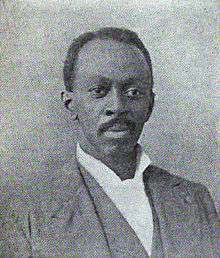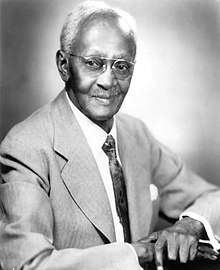Richard R. Wright
| Richard Robert Wright Sr. | |
|---|---|
 Richard R. Wright | |
| President of Georgia State Industrial College for Colored Youth | |
|
In office 1891–1921 | |
| Succeeded by | Cyrus G. Wiley |
| Personal details | |
| Born |
May 16, 1855[1] Dalton, Georgia[1] |
| Died |
July 2, 1947 (aged 92)[2] Philadelphia, Pennsylvania |
| Spouse(s) | Lydia Elizabeth (Howard) Wright |
| Alma mater |
Atlanta University[1] The Wharton School[1] |
| Profession | American military officer, educator, banker |

Richard Robert Wright Sr. (May 16, 1855 – July 2, 1947) was an American military officer, educator and college president, politician, civil rights advocate and banking entrepreneur. Among his many accomplishments, he founded a high school, a college and a bank. He also founded the National Freedom Day Association.[1]
Biography
Early life
Wright was born into slavery on May 16, 1855, in a log cabin six miles from Dalton, Georgia.[1][3]
Education
After emancipation, Wright’s mother moved with her son from Dalton to Cuthbert, Georgia. He attended the Storrs School. The school had a reputation among freedmen as a place for their children to be educated.[4] While visiting the school, retired Union General Oliver Otis Howard asked what message he should take to the North. The young Wright reportedly told him, "Sir, tell them we are rising." That exchange inspired a once-famous poem by John Greenleaf Whittier.[4][5]
The Storrs School, a forerunner of Atlanta University, was one of many academic schools for freedmen's children founded by the American Missionary Association (AMA). He was valedictorian at Atlanta University's first commencement ceremony in 1876.[3]
Republican politics
In 1890, Emanuel K. Love and Wright were in a dispute with William White, Judson Lyons, Henry A. Rucker, and especially John H. Deveaux, who was in control of Georgia's African American Republic Party machinery. The dispute centered around leadership of the party district nomination conventions. Lyons, Rucker, and Deveaux were all supported by patronage of Booker T. Washington of the Tuskegee Institute and were identified with light-skinned elites, while Love and Wright (and Charles T. Walker) represented a "black" or "darker-skinned" faction, although skin color was not as important as political allegiance and ideology.[6]
In 1896, Alfred Eliab Buck was the leader of the Georgia Republican Party. Buck was the president of the Republican State Convention in late April and presided over the electing of delegates to the 1896 Republican National Convention. There was dispute over the delegates, which Buck attempted to preempt by passing a "harmony" slate of delegates outside of standard procedure. However, the slate did not include Wright, who many believed would be a delegate. The convention erupted in protest and a representative of Buck's attempted to adjourn the meeting and the Buck faction left the hall. The Wright faction remained and Wright's friend, Emanuel K. Love took the chair, electing a new slate of delegates, now including Love and Buck (but still not Wright).[7] Eventually Wright was not selected as a delegate, but did attend as an alternate.[8]
Military career
In August 1898, President William McKinley appointed him as Major and paymaster of United States Volunteers in the United States Army. He was the first African American to serve as an Army paymaster. During the Spanish–American War, he was the highest ranking African-American officer.[5][9] He was honorably discharged in December of the same year.
Georgia State Industrial College for Colored Youth
From 1891 to 1921, Wright served as the first president of the Georgia State Industrial College for Colored Youth, a historically black college (HBCU) in Savannah, Georgia.[3] It is now Savannah State University.
During the 1890s, Wright traveled to various locations, including Tuskegee Institute, Hampton Institute, Girard College of Philadelphia, and the Hirsch School in New York, to document current trends in higher education. Based on his studies, he developed a curriculum at Georgia State College to include elements of the seven classical liberal arts, the "Talented Tenth" philosophy of W. E. B. Du Bois, Booker T. Washington’s vocationalism and self-reliance concepts, and the educational model of the New England colleges (he was a graduate of Atlanta University under the instruction of Dartmouth College and Yale University graduates).[3]
At the time, Wright was viewed as one of the leading figures of black higher education in America, conferring regularly with major educational leaders.[3] Visitors and lecturers to campus during his tenure as president included Mary McLeod Bethune, George Washington Carver, Walter Barnard Hill, Lucy Craft Laney, Mary Church Terrell, Booker T. Washington and Monroe Nathan Work.[3] U.S. presidents William McKinley and William Howard Taft also visited the campus and spoke to students in Peter W. Meldrim Hall.[3]
By the end of Wright's tenure as president, the college's enrollment had increased from the original eight students to more than 400. Additionally, he expanded the curriculum to include a normal division (for teacher training), courses in agriculture and mechanical arts, and four-year high school subjects.[3]
He was a participant in the March 5, 1897 meeting to celebrate the memory of Frederick Douglass which founded the American Negro Academy led by Alexander Crummell.[10] From the founding of the organization until 1902, Wright remained active among the scholars, editors, and activists of this first major African American learned society, refuting racist scholarship, promoting black claims to individual, social, and political equality, and publishing the history and sociology of African American life.[11]
Banker
After moving to Philadelphia, Pennsylvania, in 1921 Wright decided to open a bank. At the age of 67 he enrolled in the Wharton Business School at the University of Pennsylvania to prepare for this venture.[5] He entered the business world in 1921, creating and leading Philadelphia's Citizens and Southern Bank and Trust Company at 1849 South Street. At the time, it was the only African-American-owned bank in the North and the first African-American trust company. He also founded the Negro Bankers Association, the first African-American banking association.[5]
Under his leadership, the bank withstood the Great Depression. When it was sold in 1957, more than a decade after Wright’s death, it had assets of $5.5 million.[5]
Personal life
Wright was married to Lydia Elizabeth (Howard) Wright; together they had nine children, including Richard R. Wright Jr.
Legacy
Legacy as Civil Rights Leader
Although not nearly as well known as Rosa Parks, Richard Wright wrote a landmark letter to Harry Truman describing the horrible mistreatment of a Black returned veteran, Isaac Woodard, who was severely beaten by white policemen, who also gouged his eyes out. As a result of this letter and advocacy by the NAACP, President Truman asked his Attorney General Tom Clark to investigate. Clark brought a federal case against the police and sheriff who abused Woodard, but the all-white jury acquitted them. Wright together with others, including White liberals, advocated for a federal civil rights commission. Agreeing with this, Truman formed a Committee on Civil Rights which made far reaching and prescient recommendations, including that there should be a permanent Civil Rights division of the Justice Department and that the entire Executive branch of the federal government should be desegregated. As a result, Truman was the President who first ordered the desegregation of all branches of the military. The US military has remained desegregated ever since.
Regarding the maiming of Isaac Woodard and the aftermath, please see https://www.trumanlibrary.org/whistlestop/study_collections/desegregation/large/lessons/wright.html
In Truman's letter to AG Clark asking for an investigation of the maiming of Woodard, see https://www.trumanlibrary.org/whistlestop/study_collections/desegregation/large/lessons/clark.html On Truman forming a Committee on Civil Rights, see https://www.trumanlibrary.org/whistlestop/study_collections/desegregation/large/lessons/freedomFromFear.html
Here is a link to President Truman's order to desegregate the US military including All branches--https://www.trumanlibrary.org/anniversaries/desegblurb.htm
Family legacy
In June 1898, his son Richard R. Wright Jr. received the first baccalaureate degree awarded by Georgia State Industrial College. He went on to become the first African American to earn a Ph.D. from the University of Pennsylvania, having studied in the new field of sociology. He became a professor and later president of Wilberforce University in Ohio and a bishop in the African Methodist Episcopal Church.[3]
One of Richard Jr's daughters, Dr. Ruth Wright Hayre, also earned a Ph.D. at the University of Pennsylvania. They were the first African-American father and daughter to do so. Dr. Ruth Wright Hayre became the first full-time African-American teacher in the Philadelphia public-school system. She served as a senior high-school principal and as the first female president of the Philadelphia Board of Education. At the age of 80, she established the "Tell Them We Are Rising" program, promising to pay college tuition for 116 sixth-graders in two poor North Philadelphia schools if they completed high school. Her story was chronicled in her book Tell Them We Are Rising: A Memoir of Faith in Education, published in 1997, the year before she died.[4]
National Freedom Day
Wright invited national and local leaders to meet in Philadelphia to formulate plans to set aside February 1 each year to memorialize the signing of the 13th Amendment to the U.S. Constitution by President Abraham Lincoln on February 1, 1865, which freed all U.S. slaves.[1] One year after Wright's death in 1947, both houses of the U.S. Congress passed a bill to make February 1 National Freedom Day. The holiday proclamation was signed into law on June 30, 1948, by President Harry Truman. It was the forerunner to Black History Day and later Black History Month, officially recognized in 1976, though began by Carter G. Woodson in 1926.[5][12]
Suggested reading
- Elmore, Charles J. (1996), Richard R. Wright Sr. at GSIC, 1891–1921: A Protean Force for the Social Uplift and Higher Education of Black Americans, Savannah, Georgia: privately printed.
- Hall, Clyde W. (1991), One Hundred Years of Educating at Savannah State College, 1890–1990, East Peoria, Ill.: Versa Press.
- Patton, June O. (1996), "'And the Truth Shall Make You Free': Richard Robert Wright Sr., Black Intellectual and Iconoclast, 1877–1897", The Journal of Negro History, Vol. 81.
References
- 1 2 3 4 5 6 7 "Pennsylvania: Life and Times of Major Richard Robert Wright Sr. and the National Freedom Day Association". Retrieved 2007-08-30.
- ↑ Kranz, Rachel (2004). African-American Business Leaders and Entrepreneurs. Infobase Publishing. p. 302.
- 1 2 3 4 5 6 7 8 9 "Savannah State University". New Georgia Encyclopedia. Retrieved 2007-08-30.
- 1 2 3 "African American Firsts Highlight Rich Legacy". University of Pennsylvania. Retrieved 2008-08-30.
- 1 2 3 4 5 6 "125 Influential People and Ideas: Richard Robert Wright Sr". Wharton Alumni Magazine. Archived from the original on February 5, 2008. Retrieved 2008-08-30.
- ↑ Dittmer, John. Black Georgia in the Progressive Era, 1900-1920. University of Illinois Press, 1980. p92-93
- ↑ Shadgett, Olive Hall. The Republican Party in Georgia: From Reconstruction Through 1900. University of Georgia Press, 2010. p133-134
- ↑ Republican national convention, St. Louis, June 16th to 18th, 1896. With a history of the Republican party and a survey of national politics since the party's foundation, etc., etc, Republican National Convention (11th : 1896 : Saint Louis, Mo.), page 179, accessed October 17, 2016 at https://archive.org/stream/republicannation00repurich#page/178/mode/2up
- ↑ "Documenting the American South". Retrieved 2008-08-30.
- ↑ Seraile, William. Bruce Grit: The Black Nationalist Writings of John Edward Bruce. Univ. of Tennessee Press, 2003. p110-111
- ↑ Alfred A. Moss. The American Negro Academy: Voice of the Talented Tenth. Louisiana State University Press, 1981.
- ↑ "National Freedom Day: A Local Legacy". Retrieved 2007-08-30.
| Academic offices | ||
|---|---|---|
| New title Established school |
President of Georgia State Industrial College for Colored Youth 1891–1921 |
Succeeded by Cyrus G. Wiley |